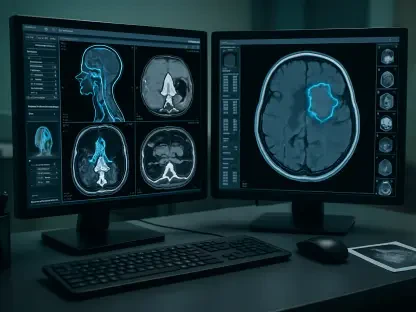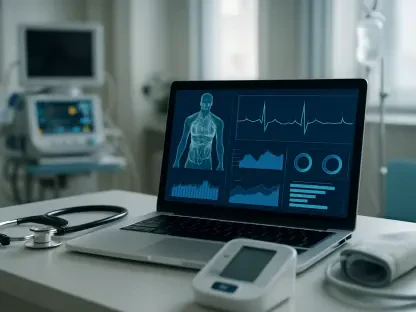In today’s data-centric world, healthcare organizations are increasingly confronting an unprecedented surge in cyberattacks, rendering data security more crucial than ever before. Healthcare data holds immense value due to its comprehensive nature, making it a prime target for cybercriminals. To navigate this complex landscape, it is imperative for healthcare entities to adopt robust cybersecurity strategies designed to protect sensitive patient information while maintaining operational efficiency.
The Growing Threat to Healthcare Data
Rising Attack Vectors
Healthcare data breaches are on the rise, with the sector witnessing 745 incidents in 2022, impacting over 52 million patient records. The substantial value of this data, primarily its Personal Health Information (PHI), makes it attractive for identity theft, insurance fraud, and even blackmail. One predominant attack vector is ransomware, affecting 66% of healthcare organizations in 2021 alone. Ransomware cripples operations by encrypting critical data, demanding a ransom for decryption, and threatening to release sensitive information.
Phishing schemes are another common attack method, tricking employees into revealing their credentials or installing malicious software. These schemes serve as gateways for more severe breaches, often leading to unauthorized access to sensitive data and further exploitation. Insider threats are also a significant concern, accounting for 39% of security incidents in healthcare. These threats can arise from employees or stakeholders who have access to sensitive information and may either intentionally or inadvertently cause data breaches. Additionally, the growing adoption of Internet of Things (IoT) devices in healthcare introduces new vulnerabilities, as these devices often lack robust security measures and can be exploited to gain unauthorized access to healthcare networks.
Consequences of Cyberattacks
The repercussions of these cyberattacks are severe, encompassing a wide range of detrimental outcomes for healthcare organizations. Financial losses are substantial, with the average cost per breach reaching $10.1 million. Beyond the immediate financial impact, these breaches lead to long-lasting reputational damage that can erode patient trust and cause significant harm to the organization’s standing in the community. Operational disruptions are another critical consequence, as cyberattacks can cripple healthcare delivery, delaying treatments and compromising patient care.
The threat to patient safety cannot be understated, as breaches can lead to the tampering of medical records, potentially resulting in incorrect treatments. Advanced Persistent Threats (APTs) further exacerbate the situation by enabling attackers to manipulate or steal data over prolonged periods without detection. The compounded effects of these attacks demonstrate the urgent need for healthcare organizations to adopt immediate and effective countermeasures. Incorporating comprehensive cybersecurity strategies can mitigate these risks, ensuring both the protection of sensitive data and the continuity of critical healthcare services.
Key Strategies for Protecting Healthcare Data
Encryption of PHI
Encrypting Personal Health Information (PHI) both at rest and in transit is crucial for safeguarding data throughout its lifecycle. End-to-end encryption ensures that data remains secure from unauthorized parties, making it difficult for cybercriminals to access or exploit the information. This security measure forms the foundation of a strong data protection strategy.
Implementing robust encryption protocols helps maintain the confidentiality and integrity of healthcare data, even in the event of a breach. Organizations should employ industry-standard encryption algorithms and regularly update their encryption practices to stay ahead of evolving cyber threats. Additionally, the use of encrypted communication channels for data transmission further enhances security by preventing interception and unauthorized access during transit. By prioritizing encryption, healthcare organizations can create a formidable defense against data breaches, ensuring that sensitive patient information remains protected at all times.
Access Controls
Implementing Role-Based Access Control (RBAC) and Multi-Factor Authentication (MFA) significantly mitigates the risk of data breaches. RBAC limits access based on specific user roles, ensuring that only authorized personnel can access sensitive information. This approach minimizes the chances of unauthorized access, as users are granted permissions tailored to their job responsibilities. MFA adds an additional layer of security by requiring multiple forms of verification, such as a password and a biometric scan, further enhancing overall data protection.
Organizations should regularly review and update their access control policies to ensure they align with the latest security standards and best practices. Incorporating context-aware access controls, which consider factors such as the user’s location and device, can provide an additional layer of security. By implementing comprehensive access controls, healthcare organizations can significantly reduce the risk of unauthorized access and protect sensitive patient information from potential breaches.
Real-Time Monitoring
Employing Security Information and Event Management (SIEM) systems, alongside AI and Machine Learning for anomaly detection, helps healthcare organizations identify and respond to threats promptly. Continuous real-time monitoring allows for the early detection of unusual activities, reducing breach detection time and enabling swift response to potential security incidents. SIEM systems aggregate and analyze data from various sources, providing a comprehensive view of the organization’s security posture.
By leveraging advanced technologies such as AI and Machine Learning, organizations can enhance their threat detection capabilities, identifying patterns and anomalies that may indicate a cyberattack. Automated response mechanisms can further improve the organization’s ability to mitigate threats quickly and effectively. Implementing real-time monitoring solutions ensures that healthcare organizations stay one step ahead of cyber threats, safeguarding sensitive data and maintaining operational integrity.
Addressing Human Factors in Cybersecurity
Employee Training and Awareness
Regular employee training and awareness programs are vital in addressing the human factor in cybersecurity. Simulated phishing attacks and continuous education help reduce the likelihood of security incidents caused by uninformed or careless employees. This proactive approach ensures that all staff members are aware of best practices and potential cyber threats.
Organizations should implement comprehensive training programs that cover a wide range of topics, including password management, recognizing suspicious emails, and responding to potential security incidents. By fostering a culture of cybersecurity awareness, healthcare organizations can empower their employees to act as the first line of defense against cyber threats. Regular refresher courses and updates on the latest threats and security practices ensure that employees remain vigilant and informed, contributing to the overall security posture of the organization.
Insider Threats
Insider threats account for 39% of security incidents in healthcare, originating from employees or stakeholders with access to sensitive information. These threats can be either intentional or inadvertent. Implementing strict access controls and monitoring systems helps detect and prevent unauthorized activities, mitigating the risk posed by insiders.
Organizations should establish clear policies and procedures for handling sensitive information and ensure that all employees are aware of their responsibilities and the potential consequences of non-compliance. Regular audits and monitoring of user activities can help identify suspicious behavior and prevent potential breaches. Encouraging a culture of accountability and transparency can further reduce the risk of insider threats, ensuring that all individuals within the organization are committed to maintaining the highest standards of data security.
Securing Network Architecture
Network Segmentation
Network segmentation involves dividing the network into smaller segments, each with its own security controls. This approach isolates sensitive systems, preventing unauthorized access and limiting the impact of a potential breach. Virtual Private Networks (VPNs) and advanced firewalls further enhance network security by protecting data during transmission.
Implementing network segmentation requires a thorough understanding of the organization’s network architecture and the identification of critical assets and data. By isolating these assets within secure segments, organizations can create multiple layers of defense, making it more difficult for cybercriminals to gain access to sensitive information. Regularly reviewing and updating network segmentation policies ensures that they remain effective in addressing emerging threats and vulnerabilities.
Patch Management
Keeping systems up-to-date through regular patch management is essential for addressing vulnerabilities. Automated patch management systems accelerate the process, ensuring critical issues are resolved promptly. This proactive measure prevents cybercriminals from exploiting known weaknesses in outdated systems.
Organizations should implement comprehensive patch management policies that include regular scanning for vulnerabilities, prioritizing patches based on the severity of the risk, and testing patches before deployment to ensure compatibility with existing systems. By maintaining up-to-date systems and addressing vulnerabilities promptly, healthcare organizations can reduce the risk of cyberattacks and protect sensitive patient information from exploitation.
Navigating Compliance and Regulatory Challenges
HIPAA Compliance
Compliance with the Health Insurance Portability and Accountability Act (HIPAA) is a legal requirement that provides a foundational framework for security practices. Regular risk assessments help identify vulnerabilities, while adopting HIPAA-compliant policies and Business Associate Agreements (BAAs) ensures stringent security measures are followed by all parties handling PHI.
Organizations should establish comprehensive compliance programs that include regular training for employees, ongoing audits, and the implementation of robust policies and procedures. By maintaining a strong focus on HIPAA compliance, healthcare organizations can effectively protect sensitive patient information and reduce the risk of data breaches.
Broader Regulatory Landscape
Healthcare organizations must also comply with the General Data Protection Regulation (GDPR) and various state-specific laws. This multifaceted regulatory environment requires comprehensive strategies and the adoption of automated compliance management tools. Staying compliant with these regulations is crucial for both legal and security reasons.
Organizations should establish a thorough understanding of the regulatory landscape and implement policies and procedures that address the unique requirements of each regulation. By leveraging automated compliance management tools, healthcare organizations can streamline the process of maintaining compliance, ensuring that all necessary measures are in place to protect sensitive patient information and avoid potential legal repercussions.
Balancing Security and Functionality
User-Friendly Security Interfaces
Striking the right balance between security and functionality is essential to avoid “security friction.” Simplified, user-friendly interfaces make it easier for employees to comply with security measures, reducing resistance and ensuring protocols are followed consistently.
Organizations should focus on designing security solutions that integrate seamlessly into existing workflows, minimizing disruptions to daily operations. By prioritizing usability and accessibility, healthcare organizations can encourage employees to adhere to security protocols, enhancing overall compliance and reducing the risk of data breaches.
Single Sign-On (SSO) Solutions
Single Sign-On (SSO) solutions enhance both security and user convenience by allowing users to access multiple systems with a single set of credentials. This approach reduces the number of passwords employees need to manage, lowering the risk of weak or reused passwords.
Implementing SSO solutions requires careful planning and integration with existing systems to ensure compatibility and effectiveness. By simplifying the login process and reducing the burden on users, healthcare organizations can improve security while enhancing the overall user experience.
Adaptive Authentication
In today’s data-driven era, healthcare organizations face an unprecedented rise in cyberattacks, making data security more imperative than ever. Healthcare data, with its detailed and comprehensive nature, is particularly valuable, turning it into a prime target for cybercriminals. This data can include everything from patient medical histories and treatments to personal identification information and financial records, all of which can be exploited if they fall into the wrong hands.
To successfully navigate this increasingly perilous landscape, healthcare institutions must adopt and implement robust cybersecurity measures. Such strategies should aim not only to protect sensitive patient information but also to ensure that the organization’s operations remain efficient and uninterrupted. This involves utilizing advanced encryption, regular security audits, and continuous staff training on best practices for data protection.
Moreover, adopting multi-layered security protocols and regularly updating software systems play a crucial role in shielding healthcare entities from potential breaches. Proactive monitoring and incident response plans are also essential components of a comprehensive cybersecurity strategy. By prioritizing these efforts, healthcare organizations can better safeguard the trust and privacy of their patients while maintaining smooth and effective operations in an ever-evolving digital landscape.









